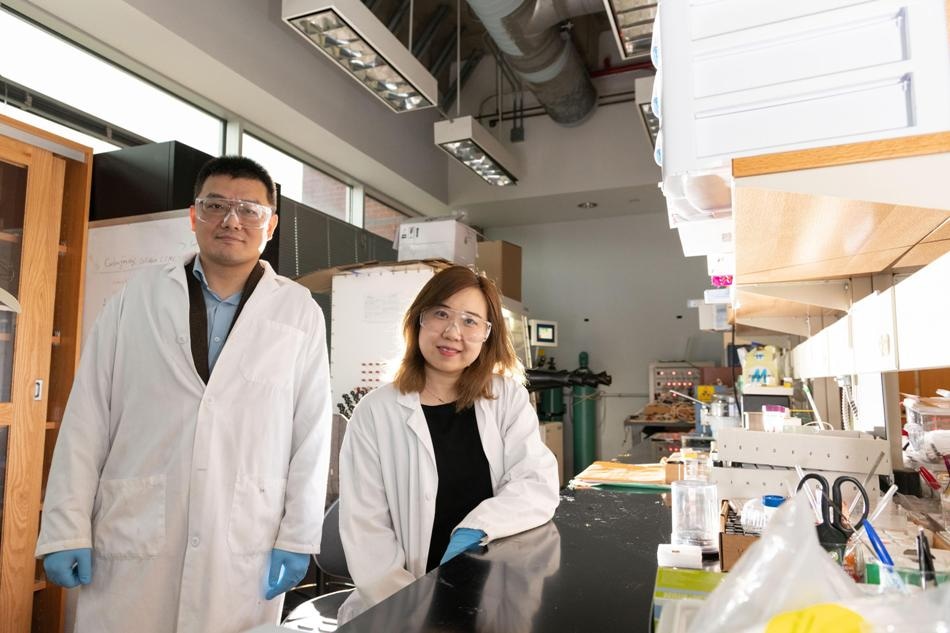Jan 8 2019
In a first-of-its-kind study, researchers used an ingenious experimental setup and high-energy X-ray beams to observe a high-temperature, high-pressure chemical reaction to establish how the formation of two varied nanoscale crystalline structures in the metal cobalt is controlled.
 Hailong Chen, an assistant professor in the George W. Woodruff School of Mechanical Engineering, and Xuetian Ma, a graduate research assistant, are shown in their laboratory. The researchers determined for the first time what controls formation of two different nanoscale crystalline structures in the metal cobalt. (Image credit: Allison Carter, Georgia Tech)
Hailong Chen, an assistant professor in the George W. Woodruff School of Mechanical Engineering, and Xuetian Ma, a graduate research assistant, are shown in their laboratory. The researchers determined for the first time what controls formation of two different nanoscale crystalline structures in the metal cobalt. (Image credit: Allison Carter, Georgia Tech)
The method enabled continuous analysis of cobalt nanoparticles as they formed from clusters that include tens of atoms to large crystals measuring 5 nm.
The study offers the proof-of-principle for a novel method to analyze the real-time formation of crystals, with prospective applications for other materials, such as oxides and alloys. The study data created “nanometric phase diagrams” that revealed the conditions controlling the structure of cobalt nanocrystals as they grew.
Published in the Journal of the American Chemical Society on November 13th, 2018, the study applied the U.S. Department of Energy-supported synchrotron X-ray beam lines at Argonne National Laboratory and Brookhaven National Laboratory. It was sponsored by the National Science Foundation.
We found that we could indeed control formation of the two different crystalline structures, and that the tuning factor was the pH of the solution. Tuning the crystalline structure allowed us to control the functionality and properties of these materials. We believe this methodology could also be applied to alloys and oxides.
Hailong Chen, Assistant Professor, The George W. Woodruff School of Mechanical Engineering, Georgia Institute of Technology
Crystal formation in bulk cobalt prefers the hexagonal close-pack, or HCP, structure since it reduces energy to produce a stable structure. However, at the nanoscale, cobalt also tends to form the face-centered cubic, or FCC, phase, which possesses a higher energy. That can be stable because the total crystalline energy is affected by the high surface energy of tiny nanoclusters, Chen informed.
“When the clusters are small, we have more tuning effects, which is controlled by the surface energy of the OH minus group or other ligands,” he added. “We can tune the concentration of the OH minus group in the solution so we can tune the surface energy and therefore the overall energy of the cluster.”
In association with scientists from the Department of Materials Science at the University of Maryland and the two national laboratories, Chen and Xuetian Ma, a graduate research assistant, studied the polymorphic structures using experimental, theoretical, and computational modeling methods.
At the experimental level, the scientists reduced cobalt hydroxide in an ethylene glycol solution, utilizing potassium hydroxide to alter the pH of the solution. The resultant reaction occurs under high pressure—approximately 1,800 pounds per square inch—and at over 200 ºC.
In the lab, a heavy steel containment vessel enabled the researchers to examine only the results of the reaction. To track how the reaction actually occurred, the team had to view it in real time, which needed the development of a containment vessel that is sufficiently small to enable X-ray transmission, and at the same time, handle the high temperature and high pressure.
This resulted in a reaction vessel made of a high-strength quartz tube measuring roughly two inches in length and approximately a millimeter in diameter. Post adding the cobalt hydroxide solution, the tube was rotated to enable the chemical reaction and also to average the X-ray signal. The required thermal energy was applied by a small heater and the temperature was measured by a thermocouple.
Chen and Ma utilized the setup during four individual trips to the Advanced Photon Source at Argonne National Laboratory, and beam lines at the National Synchrotron Light Source II at Brookhaven National Laboratory. Continuous monitoring of the chemical reaction was enabled by X-rays traveling through the reaction chamber to a two-dimensional (2D) detector. This chemical reaction took around two hours to complete.
When they started forming a detectable spectrum we captured the X-ray diffraction spectrum and continued to observe it until the crystal cobalt formed. We were able to observe step-by-step what was happening from initial nucleation to the end of the reaction.
Xuetian Ma, Graduate Research Assistant, Georgia Institute of Technology
Data acquired by altering the reaction’s pH created a nanometric phase diagram demonstrating where varied combinations created the two structures.
The results of X-ray diffraction confirmed the computational modeling and theoretical predictions done by Yifei Mo, an assistant professor in the A. James Clark School of Engineering at the University of Maryland. Mo and coworkers Shuo Zhang and Adelaide Nolan applied density functional theory to elucidate the way the crystal would nucleate under varying conditions.
The success realized with cobalt indicates that the methodology can possibly be used for producing nanometric phase diagrams for other types of materials, such as more complex oxides and alloys, said Chen.
Our goal was to build a model and a systematic understanding about the formation of crystalline materials at the nanoscale. Until now, researchers had been relying on empirical design to control growth of the materials. Now we can offer a theoretical model that would allow systematic prediction of what kinds of properties are possible under different conditions.
Hailong Chen, Assistant Professor, The George W. Woodruff School of Mechanical Engineering, Georgia Institute of Technology
As a next step, the research team at Georgia Tech intends to examine alloys, to further enhance the experimental approach and theoretical model.
Besides those already mentioned, the study also included Wenqian Xu from Argonne National Laboratory and Jianming Bai and Lijun Wu from Brookhaven National Laboratory.